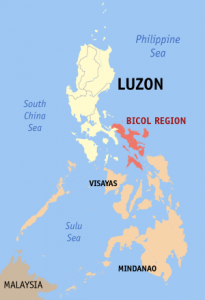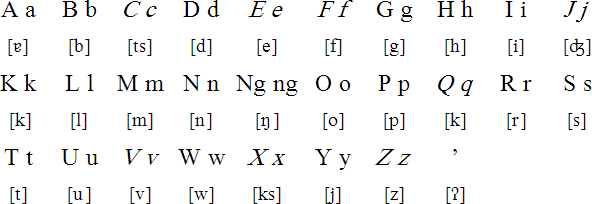 Bicol (Bikol) is a language spoken by people in the Bicol Region on southeastern Luzon in the Philippines. It was highly influenced by the Spanish language. The Bicol languages are a group of Central Philippine languages spoken mostly on the Bicol Peninsula of the island of Luzon and also part of Catanduanes and Burias Island sand Masbate province. There is a dialect continuum between the Visayan languages and the Bicol languages; the two together are called the Bisacol languages. Central Bicol or commonly called Bicol-Legazpi or Bicol-Naga is the most spoken language in the Bicol Region of southern Luzon. It is spoken in the northern and western part of Camarines Sur, second congressional district of Camarines Norte, the eastern part of Albay, the northeastern part of Sorsogon, San Pascual town of Masbate and southwestern part of Catanduanes. Central Bicol speakers can be found in all the provinces in Bicol and it is a majority language in Camarines Sur. The standard Sprachraum form is based on the Canaman dialect.
Bicol (Bikol) is a language spoken by people in the Bicol Region on southeastern Luzon in the Philippines. It was highly influenced by the Spanish language. The Bicol languages are a group of Central Philippine languages spoken mostly on the Bicol Peninsula of the island of Luzon and also part of Catanduanes and Burias Island sand Masbate province. There is a dialect continuum between the Visayan languages and the Bicol languages; the two together are called the Bisacol languages. Central Bicol or commonly called Bicol-Legazpi or Bicol-Naga is the most spoken language in the Bicol Region of southern Luzon. It is spoken in the northern and western part of Camarines Sur, second congressional district of Camarines Norte, the eastern part of Albay, the northeastern part of Sorsogon, San Pascual town of Masbate and southwestern part of Catanduanes. Central Bicol speakers can be found in all the provinces in Bicol and it is a majority language in Camarines Sur. The standard Sprachraum form is based on the Canaman dialect.
Endangered Languages
Isarog Agta and Mt. Iraya Agta (Lake Buhi Agta)
These North Bikol language variants are listed as “in danger of becoming extinct”—according to endangered languages, a website powered by data from the University of Hawaii Catalog of Endangered Languages and Eastern Michigan University’s Institute for Language Information Technology.
Isarog Agta, spoken by the Agta natives living near Mt. Isarog in Camarines Sur, only had 6 native speakers based on data taken last 2000 deeming it qualified to be tagged as critically endangered. Mt.Iraya Agta is also severely endangered as native speakers of this language are dwindling as the population is pushed to assimilate into the region and to adopt the more popular regional tongue. Estimates say that there are at most 150 speakers of this language.
Bikol/Bicol
Bikol, or Bicol, is one of the Bikol languages, which are members of the Central Philippine group of the Malayo-Polynesian branch of the Austronesian language family. Bikol is spoken by about 2.4 million people mainly on the Bicol Peninsula on the island of Luzon in the Philippines, and also on the islands of Catanduanes, Masbate, Burias and Ticao.
Before the Spanish conquest of the Philippines in the 1570s, Bikol was written with a syllabic script similar to the Tagalog one, which was used to some extent until the mid-19th century. The Spanish used the Latin alphabet to write Bikol and one of the earliest Bikol publications was the Vocabulario de la Lengua Bicol, compiled by Father Marcos de Lisboa, a Franciscan friar, between 1602 and 1611.
Bikol alphabet and pronunciation

Letters in italics are only used in foreign loan words.
Download an alphabet chart for Bikol (Excel)
Sample text in Bikol
An gabos na tawo ipinangaking may katalinkasan asin parantay sa dignidad asin derechos. Sinda gabos tinawan nin pag-isip asin conciencia kaya dapat na makipag-iriba sa lambang saro bilang mga magturugang.
Translation
All human beings are born free and equal in dignity and rights. They are endowed with reason and conscience and should act towards one another in a spirit of brotherhood.
(Article 1 of the Universal Declaration of Human Rights)
Information about Bikol | Phrases | Numbers | Tower of Babel
Bikol Sceneries
https://www.youtube.com/watch?v=4Ux1gHBMiXg
Links
Information about the Bikol languages
http://www.rosettaproject.org/archive/Bikol/view?searchterm=bikolhttp://en.wikipedia.org/wiki/Bikol_language
Sources:
https://en.wikivoyage.org/wiki/Bikol_phrasebook
https://saminovic.wordpress.com/language/business/
http://wowlegazpi.com/useful-bicol-phrases/
http://wikitravel.org/en/Bikol_phrasebook

